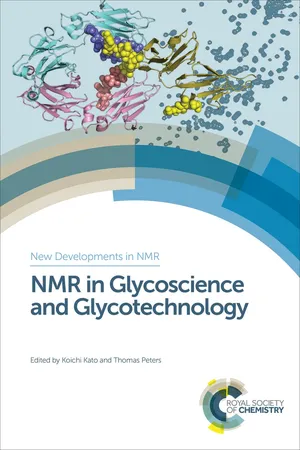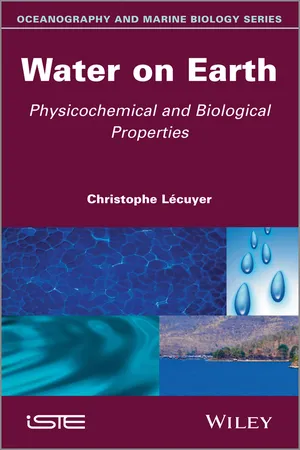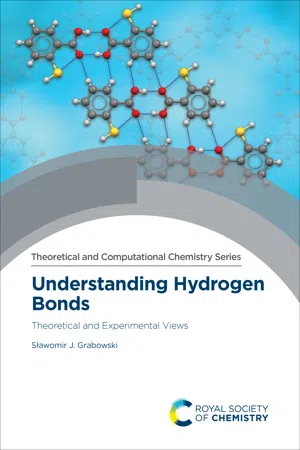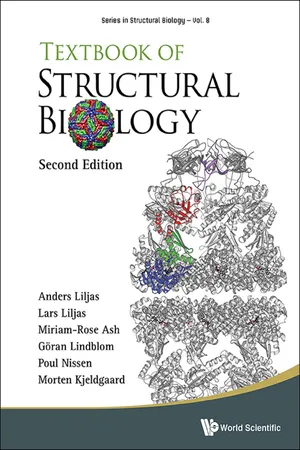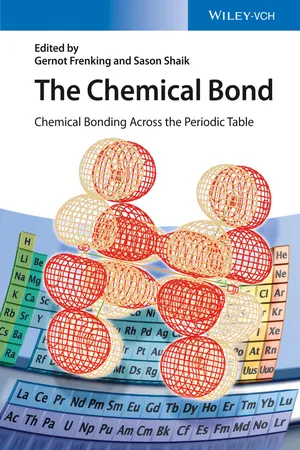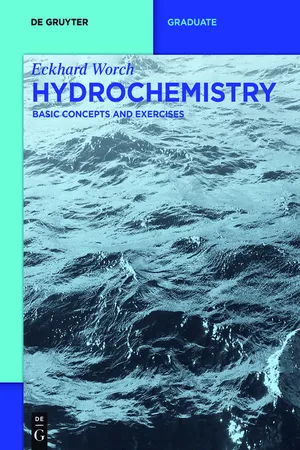Biological Sciences
Hydrogen Bonding in Water
Hydrogen bonding in water refers to the attractive force between the hydrogen atom of one water molecule and the oxygen atom of another. This unique type of bonding gives water its high surface tension, cohesion, and ability to moderate temperature. In biological systems, hydrogen bonding in water is essential for maintaining the structure and function of biomolecules.
Written by Perlego with AI-assistance
Related key terms
Related key terms
1 of 4
Related key terms
1 of 3
10 Key excerpts on "Hydrogen Bonding in Water"
- eBook - ePub
- Koichi Kato, Thomas Peters(Authors)
- 2017(Publication Date)
- Royal Society of Chemistry(Publisher)
Researchers in glycan structure determination spend a lot of time chasing their own tails. Because the molecular structures of glycans are more flexible than proteins and DNA, it is sometimes difficult to definitively delineate glycan ″structure″. A perusal of the literature will give one the impression that, for a given glycan in solution, multiple structural possibilities are generally predicted by modeling; however, it is challenging to determine which possibilities are the most reasonable due to ambiguities present in both experimental and modeling data. Thus, solution studies, especially NMR spectroscopy, should aim to provide far more definitive, quantitative parameters to improve model parameterization. Consequently, computer modeling can be more predictive than it is presently. Naturally, this will lead to a more detailed and complete understanding of the forces that dictate glycan structure and conformations. Ultimately, it may even provide a framework to understand and predict chemical reactivity of glycans. One extremely important structural parameter known to contribute to structural stability is hydrogen bonding (Hbonding) in aqueous solution and it is the focus of this chapter.Hbonding is a vital weak inter/intra-molecular interaction, which is especially important in biological molecules. On one hand, Hbonds can be seen as a putative proton transfer; on the other, Hbonds can stabilize biological structural motifs in proteins, DNA and RNA without proton transfer.The strength of Hbonds ranges from 1–40 kJ mol−1 .1 Though strong for a non-bonded interaction, it is only a fraction of the strength of a typical covalent bond. Thus, in many biomolecules multiple Hbonds are used to increase the stability of different structural motifs in proteins and nucleic acids.Hbonding is defined as an interaction between an electronegative atom and a hydrogen atom covalently bonded to an electronegative atom, such as fluorine, oxygen, nitrogen and sometimes carbon. The electrons in the X–H polar covalent bond are delocalized toward the former of the two electronegative atoms (Figure 1.1 ).Figure 1.1 Hydrogen bond scheme of a molecular fragment bearing an OH group. The dashed red line highlights a hydrogen bond where electron density on the oxygen atom is donated to a hydrogen atom covalently bonded to a different oxygen atom. The latter oxygen atom may be a water molecule as well.As stated previously, Hbonding is a recurrent structural feature found in proteins and nucleic acids. We were convinced that Hbonds are important in glycans too. Therefore, we sought evidence in support of Hbonding in oligo- and polysaccharides and the methods we developed may be useful in other applications as well. Hbonding in solution has only recently been directly detected in glycans using NMR.2 –7 - eBook - ePub
- Leonard J. Banaszak(Author)
- 2000(Publication Date)
- Academic Press(Publisher)
(Temperature factors are discussed in Chapter 2.) There is one last but important description about water molecules attached to crystalline proteins. Since hydrogen atoms are not visible, the scientist interpreting any electron density map has no information as to the ionic form of the water molecules. In some cases, they probably exist as H 2 O, but in exceptional cases, they may be either OH – or H 3 O +. HYDROGEN-BONDING POSITIONS IN PROTEINS With the hypothesis that any bound water molecule must be hydrogen bonded to a polar atom in the protein or another water molecule, any potential hydrogen bond donor or acceptor within a protein molecule could be a binding site. The basis for this dipole–dipole interaction is quite simple. Hydrogen covalently bonded to nitrogen or oxygen atoms results in a slight positive charge associated with the hydrogen atom. This can interact with negative dipolar formations associated with sp 2 or sp orbitals also found on oxygen or nitrogen atoms that are covalently part of a protein. A somewhat broader definition of a hydrogen bond is that it is assumed to exist if the two heteroatoms are separated by a distance governed by an angular dependence of the dipolar alignment. Kabsch and Sander (1983), before defining a computational method for defining secondary structure, developed an equation for analyzing the relative strength of hydrogen bonds between the carbonyl oxygen and the hydrogen linked to the nitrogen of peptides. It is instructive even if it does not apply directly to water molecules hydrogen bonded to proteins. A graphical representation of the relative energies of main-chain hydrogen bonds is also shown in Fig. 9.1. Note: These are energies tied to the electrostatic interactions, not the free energy of stabilization attributable to the hydrogen bond. The energy contours starting at −0.5 kcal/mol are directly related to the separation distance and the angle θ - No longer available |Learn more
- Mary Wuerth(Author)
- 2023(Publication Date)
- Barrons Educational Services(Publisher)
UNIT 1Chemistry of Life
Passage contains an image
3
Water
Learning Objectives In this chapter, you will learn:➜Water and the Importance of Hydrogen Bonds➜pHOverview
Living organisms contain more water than any other compound. The environment of most living organisms is dominated by water. Understanding water and its properties is key for the study of life on Earth. This chapter will review water’s unique properties and how these properties affect living organisms.Water and the Importance of Hydrogen Bonds
Water is a polar molecule. Its polarity allows it to form hydrogen bonds. These hydrogen bonds give water properties that are essential to life on Earth.Water contains covalent bonds (shared electrons) between the oxygen and hydrogen atoms. The element oxygen has a high electronegativity (ability to attract electrons), while the element hydrogen has a lower electronegativity. Because of this electronegativity difference, the electrons in the covalent bond between oxygen and hydrogen are unequally shared, with the electrons spending more time around the oxygen atom. This results in a polar covalent bond, with a partial negative charge around the oxygen atom and a partial positive charge around the hydrogen atom, as shown in Figure 3.1 .Figure 3.1 Polarity of WaterAs a result, the partial negative charge on an oxygen atom in one water molecule is attracted to the partial positive charge on a hydrogen atom in another water molecule, resulting in a hydrogen bond. This causes water molecules to be attracted to one another, as shown in Figure 3.2 .Figure 3.2 Hydrogen Bonds Between Water MoleculesSince water molecules can form hydrogen bonds, they have properties that help sustain life on Earth, including:- Exhibiting cohesive and adhesive behavior: Water molecules are “sticky.” They are attracted to other water molecules and to other polar molecules. This is what gives water its unique properties like water’s high surface tension and its ability to climb up the xylem in plants through capillary action. (See Figure 3.3
- eBook - ePub
Water on Earth
Physicochemical and Biological Properties
- Christophe Lécuyer(Author)
- 2013(Publication Date)
- Wiley-ISTE(Publisher)
Chapter 1
Water: A Molecule Endowed with Extraordinary Physicochemical Properties
1.1. Molecular geometry and electrical properties
A water molecule consists of an oxygen atom bonded to two hydrogen atoms. In water, each hydrogen atom is bound to the oxygen by a pair of electrons. However, only two of the six outer-shell electrons of oxygen are used to form covalent bonds, the remaining four being organized into two non-bonding pairs (Figure 1.1 ). The four electron pairs surrounding the oxygen tend to arrange themselves as far from each other as possible in order to minimize repulsions between these clouds of negative charge. However, the two non-bonding pairs exert a strong repulsion against the two covalent bonding pairs, which results in a deformed tetrahedral geometry with a angle of 105° instead of the theoretical angle of 109°. As a result, the H2 O molecule is electrically neutral even though the electrical charges are not distributed uniformly. Indeed, a negative charge is associated with the oxygen atom while the hydrogen atom carries a positive charge (Figure 1.2 ). This electronic configuration defines the polar structure of water molecules, which consequently have a mutual attraction and tend to stick together.This process is called “hydrogen bonding” and explains why water is a liquid instead of a gas under standard conditions (close to the Earth’s surface pressure and temperature conditions). In comparison to a covalent bond, the hydrogen bond is so weak that the timescale of its life expectancy is in the order of the picosecond (10−12 s), therefore explaining the low molecular viscosity of water ( - eBook - ePub
- Jacob N. Israelachvili(Author)
- 2010(Publication Date)
- Academic Press(Publisher)
2 distance dependence, which is the same as that expected for the charge-dipole interaction, previously given by Eq. (4.5) as(8.1)This equation may be expected to apply because, as explained in Sections 4.9, the positive H atom is so small that its interaction with a dipole falls in between the charge-charge and dipole-dipole interactions. But the magnitude of this charge is not the full electronic charge +e and is not known in advance. And neither is r . For example, for the water-water H-bond, if we inserted into Eq. (8.1) the values Q = 0.24e = 0.4 × 10–19 C (see the model of water in Figure 8.4 ), u H 2 O = 1.5 D = 5 × 10−30 C m (the dipole moment of water), r = 0.176 + (0.100/2) = 0.226 nm (the distance between H+ and the center of the O− H+ dipole), θ = 0, and ɛ = 1, we obtain w (r ) ≈ −3.4 × 10−20 J = 20.4 kJ mol−1 = 4.9 kcal/mole. This agrees very well with the literature value of 4.5 kcal/mole for the water-water H-bond.Hydrogen bonds can occur intermolecularly as well as intramolecularly and can happily exist in a nonpolar environment. They are consequently particularly important in macromolecular and biological assemblies, such as in proteins, linking different segments together inside the molecules, and in nucleic acids, where they are responsible for the structure of the DNA molecule.3 Their involvement in setting up one-, two-, and three-dimensional macromolecular structures is sometimes referred to as hydrogen-bond polymerization (illustrated in Figure 8.2 a, b and c).8.3 Models of Water and Associated Liquids
Hydrogen bonds play a particularly prominent role in water, since each oxygen atom with its two hydrogens can participate in four such linkages with other water molecules: two involving its own H atoms and two involving its unshared (lone-pair) electrons with other H atoms. To see exactly how this arises, we require some picture of the charge distribution within the water molecule. Numerous models have been proposed (Allen and Tildesley, 1987; Ciccotti et al., 1987; Mahoney & Jorgensen, 2000; Guillot, 2002), but no single model has been able to satisfactorily account for the properties of water in all three phases (ice, liquid, and vapor) and especially its unusual interactions, discussed below, such as the hydrophobic interaction. Figure 8.4 - eBook - ePub
Understanding Hydrogen Bonds
Theoretical and Experimental Views
- Sławomir J Grabowski(Author)
- 2020(Publication Date)
- Royal Society of Chemistry(Publisher)
CHAPTER 1 Hydrogen Bond – Definitions, Criteria of Existence and Various Types1.1 Definitions of Hydrogen BondIt is often controversial who first introduced the term hydrogen bond and which were the first studies on this kind of interaction. It is not discussed and described in detail here because it has been done in former review articles and monographs.1 – 7 However, it is worth mentioning a few early studies on terms related to the hydrogen bond and on definitions because they are important to understand the descriptions and explanations that appear further in this book. Various statements and explanations mentioned in this chapter show that many ideas and models that have often appeared recently in numerous articles have their roots in very early studies; sometimes such studies come from the beginning of the twentieth century.It seems that M. L. Huggins was the first to introduce the concept related to the hydrogen bond in a thesis of the advanced inorganic chemistry course at the University of California in 1919.8 This concept was further clarified and applied by W. M. Latimer and W. H. Rodebush in a study on polarity and ionization phenomena that were described in terms of the Lewis theory of valence.9 The authors stated that ‘in terms of the Lewis theory, a free pair of electrons on one water molecule might be able to exert sufficient force on a hydrogen held by a pair of electrons on another water molecule to bind the two molecules together’. Next they explain, ‘Such combination need not be limited to the formation of double or triple molecules. Indeed the liquid may be made up of large aggregates of molecules, continually breaking up and reforming under the influence of thermal agitation. Such an explanation amounts to saying that the hydrogen nucleus held between 2 octets constitutes a weak bond’.9 The latter statement (in italics) may be treated as the first definition of the hydrogen bond, or at least one of the first definitions. Latimer and Rodebush present ammonium hydroxide as an example of such an arrangement and next they show numerous examples of structures existing in liquids and fulfilling the rules of the Lewis model; among them, arrangements which may be classified as hydrogen bonds are discussed.9 One can see that numerous topics early discussed by Latimer and Rodebush are analysed further in various studies; not only is the hydrogen bond interaction a subject of such further studies but also cooperativity effects, thermal motions in water, Lewis structures of various species, etc. It is important that the authors also stated in their article that ‘Mr. Huggins of this laboratory in some work as yet unpublished, has used the idea of a hydrogen kernel held between two atoms as a theory in regard to certain organic compounds’.9 - eBook - ePub
Enzyme Kinetics: Catalysis and Control
A Reference of Theory and Best-Practice Methods
- Daniel L. Purich(Author)
- 2010(Publication Date)
- Elsevier(Publisher)
i.e ., most stable) when the three atoms of the bond are co-linear (typically, θ = 180° ± 15°). The distance between electronegative atoms is reduced from the calculated van der Waals radii by hydrogen-bond formation.Inter-amide hydrogen bonds are said to play only a compensatory role in stabilizing protein structure, because their corresponding transfer reaction (e.g ., [–N–H···OH2 + H2 O···O C–]unfolded [–N–H··· O C– + + H2 O··· HOH]folded ) typically has a ΔG value of zero. On the other hand, α-helix and β-sheet formation helps to organize protein folding reactions and to dehydrate the interior of globular proteins.Jencks (1969) emphasized that the hydrogen bond interaction resembles an intermediate stage of proton transfer from an acid to a base. A sufficiently strong base will hold the proton closer, thereby stretching and weakening the proton’s association with the acid. Complete transfer to the base would break the hydrogen bond. Hence, the strength of a hydrogen-bonding interaction is optimal when the acidity of the donor and the basicity of the acceptor are well matched.Hydrogen bonds can also play significant roles in promoting molecular recognition, and in shuttling protons in and out of active sites. An individual hydrogen bond contributes 0.5–1.8 kcal mol−1 (or 2–7.5 kJ mol−1 ) to substrate binding energy, often increasing specificity by a factor of 2–20. This value was estimated by assessing the effects of deleting a hydrogen bond to an uncharged hydrogen bond donor/acceptor pair (Fersht, 1987). A larger value of 3–6 kcal mol−1 (or 12.5–25 kJ mol−1 ) is typically observed, if one deletes a hydrogen bond for a charged donor/acceptor. As discussed in Section 3.7.1, Grotthuss chains consisting of a linear array of hydrogen bonds play important roles as “proton wires,” where protonation at one end of a chain promotes distal deprotonation, and vice versa. For efficient proton translocation, a proton-conducting wire must exist, made of water molecules and/or ionizable amino acid side chains. Fast proton transfer in water (diffusivity D H + = 9.3 × 10−9 m2 - eBook - ePub
- Anders Liljas, Lars Liljas;Miriam-Rose Ash;G?ran Lindblom;Poul Nissen;Morten Kjeldgaard(Authors)
- 2016(Publication Date)
- WSPC(Publisher)
Not only would burying an isolated ionic group inside the protein or in the core of the lipid bilayer cause a loss of the solvation energy, but there would also be an electrostatic price to pay. The attraction between two oppositely charged ions is given by Coulomb’s law, being proportional to e 2 /εr, where e is the unit charge, r is the distance between the ions considered as point charges, and ε is the dielectric constant of the medium in which they are located. In aqueous solution ε is roughly 80, whereas it is much lower inside the hydrophobic core of proteins or the lipid bilayer where it is about 2-20. Thus, if a charge is buried, there is an enormous energetic advantage in burying a suitable opposite charge as close as possible. This is one of the reasons for the formation of saltbridges, for example, and why we need channels in membranes to transport ions through the membrane (Chapter 13). Concerning the interactions and binding of ions to charged surfaces on proteins or membranes, the theory is more sophisticated. This pertains also to situations where we consider interactions between, for example, two membranes of the same or different charge or even one neutral and one charged membrane. Osmotic pressures and entropic forces will be involved in such events, and it is outside the scope of this book. 2.1.4 Hydrogen Bonds Hydrogen bonds are central in biology. They contribute by stabilizing and orienting chemical groups with regard to each other. A proton interacting with two adjacent electronegative atoms with lone electron pairs (called the donor and acceptor) can form a hydrogen bond. These terms indicate that the proton can for some fraction of time be bound to either atom. The direction and the distance between the hydrogen bond donor and acceptor vary. The strength of a hydrogen bond is primarily related to its length and linearity. Normally hydrogen bonds are around 2.8 Å in length and the ΔH (change in enthalpy) of forming the bond is around 20 kJ/mol - eBook - ePub
The Chemical Bond
Chemical Bonding Across the Periodic Table
- Gernot Frenking, Sason Shaik(Authors)
- 2014(Publication Date)
- Wiley-VCH(Publisher)
The Nature of the Chemical Bond) [8], Moore and Winmill made the first mention of the H bond, and Latimer and Rodebush recognized the importance of the H bond. Since those early days, there has been an overwhelming body of research, using X-ray crystallography, spectroscopic methods, and emerging quantum chemistry, that has made significant contributions to the enhancement of our knowledge and understanding of the H bond. However, past studies have also shown that there are many different types of H bonds and that the attributes of H bonding are much more complex and broader than previously assumed. As such, even with its history of around 100 years, the H bond is still a growing research area. The purpose of this chapter is not to discuss the diverse field of H bonding research in a comprehensive or exhaustive manner. Rather, we intend to summarize the nuts and bolts of H bonding, with some emphasis placed on the contributions of theoretical chemistry.17.2 Fundamental Properties of Hydrogen Bonds
Despite its ubiquity, it is not necessarily straightforward to define the H bond without ambiguity. A H bond can be generally described as17.1where X and Y are normally highly electronegative atoms. Although the dotted line in Eq. (17.1 ) constitutes the main part of the H bond, the H bond actually refers to the whole structural moiety composed of the three atoms, X, H, and Y [1e]. Chapter 12 of Pauling's The Nature of the Chemical Bond (third ed.) [8b] opens with the following sentences: “It was recognized some decades ago that under certain conditions an atom of hydrogen is attracted by rather strong forces to two atoms, instead of only one, so that it may be considered to be acting as a bond between them. This is called the hydrogen bond.” According to the definition by Pimentel and McClellan, a H bond exists between X–H and Y when “(a) there is evidence of bond formation (association or chelation) and (b) there is evidence that this new bond linking X–H and Y specifically involves the hydrogen atom already bonded to X [1a]”. More recently, Steiner proposed the following definition: an X–H Y interaction is called a hydrogen bond - eBook - ePub
- Eckhard Worch(Author)
- 2015(Publication Date)
- De Gruyter(Publisher)
2 Structure and properties of water2.1 Structure of water
The isolated triatomic H2 O molecule has an angled shape. The O–H bond lengths are 96 pm and the angle between the bonds is 104.5° (Figure 2.1 ). The bonds between hydrogen and oxygen are single covalent bonds, each consisting of a bonding electron pair (one electron from oxygen and one electron from hydrogen). The bonding partners oxygen and hydrogen have different tendencies to attract the bonding electrons towards themselves. This tendency is quantified by the measure electronegativity which has, in the Pauling scale, the value 3.44 for oxygen and 2.2 for hydrogen, respectively. Accordingly, oxygen has a higher tendency to attract the bonding electrons, which leads to a higher electron density at the oxygen atom in comparison to that at the hydrogen atom. As a consequence, the atoms possess partial charges (oxygen: δ = -0.34, hydrogen: δ = +0.17). Here, partial charge means that there is only a shift in the electron density but not a complete gain or loss of an electron as in the case of univalent ions (e.g. Cl– , Na+ ) which have full charges (–1, +1).As a consequence of the occurrence of opposite charge centers within a certain distance, dipole moments (dipole moment = charge x distance) exist along the bond axes and, because the molecule is not linear, a total dipole moment also exists for the molecule. Vector addition of the dipole moments along the axes leads to a total dipole moment of 1.84 D, where Debye (D) is the unit that is typically used for dipole momeets. 1 D is equivalent to 3.33 x 10–30 C · m, where the charge is given as coulomb (C) and the distance is given as meter (m). The relatively high value of the dipole moment indicates that water is a strongly polar molecule.The molecular geometry of H2 O can be explained by a sp3 hybridization of the orbitals of the oxygen atom within the water molecule (Figure 2.2 ). The oxygen atom possesses eight electrons. Six of them are valence electrons, which reside in the outermost electron shell and can participate in the formation of chemical bonds. Whereas the ground state of a single oxygen atom is characterized by the existence of one 2s and three 2p orbitals, which contains the six valence electrons (left-hand side of Figure 2.2 ), the electron configuration of the oxygen atom in the water molecule is different and can be explained by four sp3 hybrid orbitals (‘mixed’ orbitals) of equal energy that contain the six valence electrons (right-hand side of Figure 2.2 ). The 1s orbital of the oxygen is not involved in bonding and remains unchanged. Two of the four sp3 hybrid orbitals are occupied by two electrons each and two are occupied by only one electron each. Each of the half-filled sp3
Index pages curate the most relevant extracts from our library of academic textbooks. They’ve been created using an in-house natural language model (NLM), each adding context and meaning to key research topics.
Explore more topic indexes
Explore more topic indexes
1 of 6
Explore more topic indexes
1 of 4
